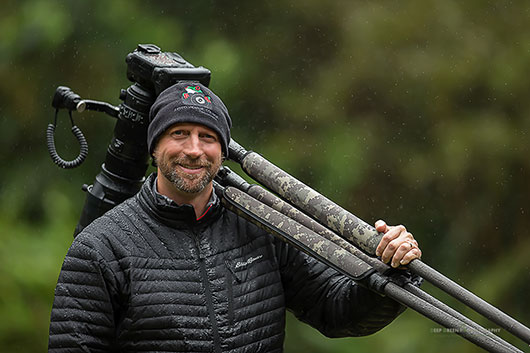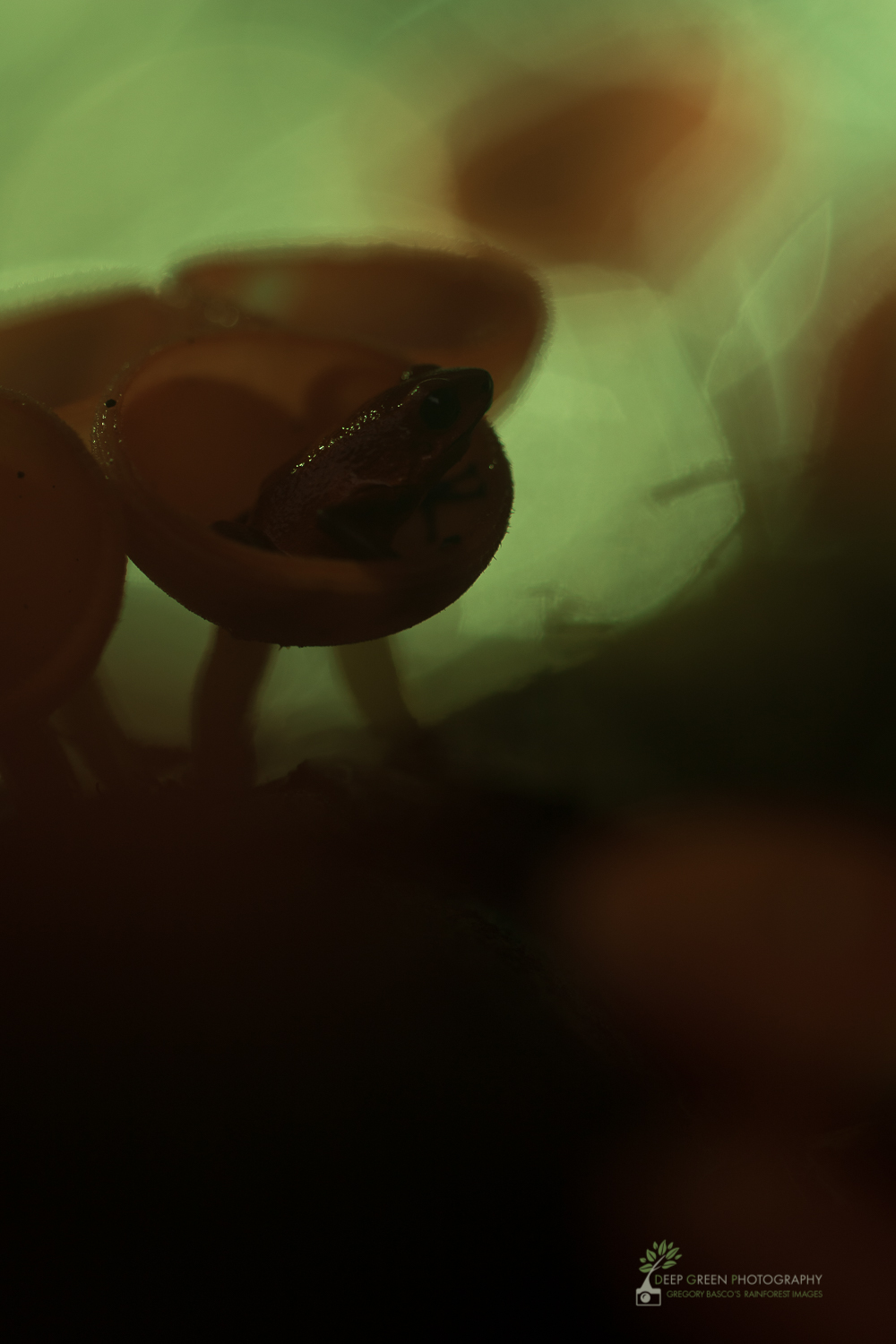Many nature photographers profess to shoot only natural light because they don’t like flashed-looking pictures. While often said as if it were a badge of honor, this statement is actually an admission that the photographer doesn’t know how to use flash, one of our most important tools! Employed properly, flash can look completely natural and help any photographer get the shot when the natural light is less than ideal. Flash saved the day for me with this shot of a tiny Strawberry Poison Frog (Oophaga pumilio) in a Costa Rican rainforest last year.
Strawberry Poison Frogs are members of the poison arrow/dart frog family. They have toxins in their skin and often sport bright colors to warn predators of their toxicity (scientists call this aposematism). These frogs are a little over an inch long and are diurnal, spending their time on the forest floor in search of fruit flies and ants (the latter of which provide the ingredients for poison frogs’ toxins). While with a friend one day, we found this little poison frog on a rotting log that was covered with orange cup fungus. Using a small stick, we coaxed the frog onto one of the tiny mushrooms, and I got to work.
Camera Settings
Most macro photographs are taken with small apertures to maximize depth of field. I wanted to do the opposite here to produce a dreamy kind of effect. While shooting in manual mode, I selected f/4.5. On a sunny day in the rainforest, dappled light is almost always the rule, and in this case the sun was hitting some green leaves just behind the frog, but the frog and the mushrooms were in relative shadow. I chose to expose my background properly by choosing a low ISO value of 100 which meant the proper shutter speed was 1/2000 of a second. As you can see in the photo below, my background looks great, but I am left with a dynamic range problem.
Landscape photographers are familiar with dynamic range issues and solve them by using HDR or blending multiple bracketed exposures in Photoshop. But wildlife and macro photographers obviously can’t use these solutions because their subjects are moving. I was lying down and shooting handheld so doing HDR or blended exposures were even less feasible as potential solutions. Flash was the obvious answer!
Now I was faced with two more challenges. First, I want to make the flash look natural. That always means getting the flash off-camera and diffusing it in some way. I always have a small softbox and radio flash transmitters and receivers in my bag so that was no problem. Second, I had to use a flash mode called high speed sync that allows us to use flash at fast shutter speeds. Recall that I wanted to shoot at an open aperture for the effect I wanted. Even at a low ISO that left me with a shutter speed of 1/2000. My Phottix Odin radio flash transmitter and receiver support high-speed sync flash, so I was ready to go. I set my flash in TTL mode and dialed in -1/3 stop flash exposure compensation as my flash was doing pretty much all the work, illuminating the frog and the mushrooms. I worked holding the camera in my right hand and my flash with my left hand. Note below how the flash looks very natural; that’s the result of getting the flash off-axis and diffusing it.
Composition
I took a number of different compositions, both horizontal and vertical, but framed this one thinking of a magazine cover possibility. The image above is full-frame with no cropping. Holding the camera with one hand and the flash with the other can make composing difficult. But, by supporting my camera hand with my elbow and choosing an autofocus point that covered the eye of the frog, the job was made a lot easier. The battery grip on my camera also allowed me to shoot much more comfortably in vertical orientation.
Processing
I use Lightroom for the vast majority of my processing, and this image was no exception. I used the HSL panel to deal with some of the color tones in the image, targeting especially the greens, reds, and oranges. I also employed a few adjustment brushes to do some light dodging and burning and color adjustments on a few areas of the image. Processing took no more than a couple of minutes.
The Lesson
Envisioning the type of photo that you want to create rather than simply shooting a subject is what takes your photos from snapshots to artistic imagery. Flash can assist you solving exposure problems in the field when the natural light isn’t giving you what you want and can be a great tool in helping you to realize your creative vision!
 About the author: Greg Basco is a professional nature photographer and environmentalist based in Costa Rica. You can view more of his work at www.deepgreenphotography.com. If you’d like to join Greg in Chile this October, visit his photo tour company’s website www.fotoverdetours.com.
About the author: Greg Basco is a professional nature photographer and environmentalist based in Costa Rica. You can view more of his work at www.deepgreenphotography.com. If you’d like to join Greg in Chile this October, visit his photo tour company’s website www.fotoverdetours.com.
Have something to add to the story? Leave a comment or email editor@outdoorphotographyguide.com.




Nice work Greg. I like the soft focus, and of course the fill in flash is just right.